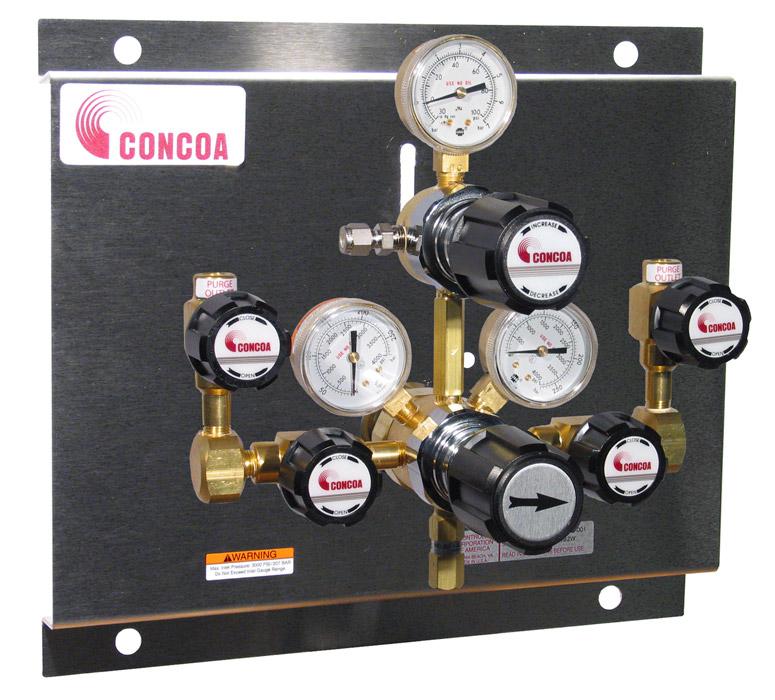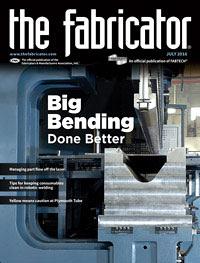Application Specialist
- FMA
- The Fabricator
- FABTECH
- Canadian Metalworking
Categories
- Additive Manufacturing
- Aluminum Welding
- Arc Welding
- Assembly and Joining
- Automation and Robotics
- Bending and Forming
- Consumables
- Cutting and Weld Prep
- Electric Vehicles
- En Español
- Finishing
- Hydroforming
- Laser Cutting
- Laser Welding
- Machining
- Manufacturing Software
- Materials Handling
- Metals/Materials
- Oxyfuel Cutting
- Plasma Cutting
- Power Tools
- Punching and Other Holemaking
- Roll Forming
- Safety
- Sawing
- Shearing
- Shop Management
- Testing and Measuring
- Tube and Pipe Fabrication
- Tube and Pipe Production
- Waterjet Cutting
Industry Directory
Webcasts
Podcasts
FAB 40
Advertise
Subscribe
Account Login
Search
Cutting to the chase on gas delivery for CO2 lasers
Know the basics of gas usage in laser cutting to get the most out of the equipment
- By John Karpus
- June 29, 2016
- Article
- Laser Cutting

Figure 1
A CO2 laser cutting machine by its very name suggests how important gases are to its operation. CO2 is one of the gases needed to create the laser beam. Other gases, such as nitrogen and oxygen, are used to refine a cut for a specific application.
Metal fabricators typically have a lot of questions about what is required to set up a new or second-hand CO2 cutting laser (see Figure 1). The two things they all definitely want are for the equipment to work correctly and to work efficiently.
A basic understanding of how a laser uses gases can, of course, help assist in setting up the gas delivery system required to operate the laser. The sweet spot to working with these applications is understanding the three basic factors that affect how the gases operate: purity, pressure, and flow.
High Purity
The resonator is the part of the laser that creates the cutting beam, using nitrogen, helium, and CO2 gases. The purity grade of these gases must be 5.0 or higher, and inlet purging must be done before they reach the resonator. Depending on the laser manufacturer, the resonator gas may come as three separate components, each requiring an individual gas delivery system, or all three gases may be combined into a premix cylinder. Small amounts of carbon monoxide can also be added to the resonator gas mix, depending on the laser manufacturer.
When a new resonator gas cylinder in installed, ambient air will enter the inlet of the regulator or flexible hose unless precautions are taken. A short three- to five-second purge should be adequate to remove the ambient air, moisture, and any contamination before the resonator gas enters the resonator. This purge is a critical step that cannot be overlooked.
If the ambient air contamination is not removed from the gas stream prior to its entry into the resonator, it will damage the optics in the resonator and over time cause the beam quality to degrade. When that happens, the laser will start to consume more power, and the quality of the cut will diminish to such a point that a factory service tech will need to be called in to repair the laser.
The cost of the technician and the parts involved is only half the pain. Having the laser down for a day or so is the other half of this stinging scenario.
A cutting laser operating at ramp speed can produce tens of thousands of dollars an hour in revenue, which is bottom-line motivation for most shops to invest wisely in laser cutting technology. Many lasers are sold with material handling capabilities so the machine can be run 24/7, unattended. That said, if the laser is not supplied with a consistent, uninterrupted gas source, it will shut down.
If you decide to purchase a basic regulator (see Figure 2) to supply the resonator gas, when the cylinder runs out, the laser will shut off until a new cylinder is hooked up. A switchover manifold (see Figure 3) is an effective solution for supplying an uninterrupted flow of resonator gas to the laser. Some laser manufacturers have developed resonators that use such small amounts of these gases that the machines come supplied with a cylinder that does not have to be replaced for a year or more.
Since maintaining gas purity is the objective, using a resonator gas regulator mounted to the wall and a flexible hose or pigtail to make the connection to the cylinders is an excellent approach for three good reasons:
- Eighty percent of damage to regulators occurs during cylinder changeout. Mounting the equipment on the wall gets the regulator out of harm’s way.
- A wall-mounted regulator can use stainless steel tubing to connect the outlet of the regulator (tube fitting) to the back of the laser. Metal-to-metal seals ensure a leak-tight seal. It is worth noting that leaks cannot only cause outflow, they can also vent ambient air into the gas stream.
- Flexible hoses can be supplied with check valves built into the compressed gas/air (CGA) cylinder connection. Check valves minimize the purge cycle and the chance of ambient air reaching the resonator.
It makes the most sense, of course, to always follow the laser manufacturer’s guidelines for the maximum inlet pressure allowed at the back of the laser. Relief valves that protect the resonator should the gas delivery system fail also should be installed in the line before the gas inlet at the back of the laser.

Figure 2
With a basic regulator supplying resonator gas, the laser shuts off when the cylinder runs out.
Even though the resonator gas grade is high purity, some laser manufacturers recommend the use of 2-micron filters to ensure that no particulate contamination reaches the resonator.
Pressure and Flow
The assist gases used on a CO2 cutting laser are oxygen and nitrogen. Sometimes air can be used for this process, but the costs of dealing with particulate filtering and moisture removal often encourage metal fabricators to use nitrogen as they view it as a more attractive option. The grade of the assist gas will make a difference in the cut quality. For this reason, most laser manufacturers recommend a grade of 4.5 or better.
Oxygen cutting pressures can range from 100 to 400 pounds per square inch (PSI), and consumption can be from 100 to 4,000 standard cubic feet per hour (SCFH). Nitrogen cutting pressures are typically 300 to 500 PSI, and consumption can be from 1,000 to 6,000 SCFH at the back of the laser.
The high-flow requirements of laser assist gases call for the use of dome-loaded regulators. A high-flow regulator that could be used on a high-pressure cylinder or cradle, liquid cylinder, or bulk tank line is preferred. High-pressure cylinder cradles can be used for startup or low-flow applications, but are inefficient and costly when the application demands higher flows.
Another restrictive factor is that even though 12 to 18 high-pressure cylinders are manifolded together on a cradle and each cylinder contains 200 to 300 cubic feet of gas, the gas flow through a valve, CGA connection, and a flexible hose is limited.
High-pressure cylinder cradles often have two outlet valves, with the smallest orifice in any system being the limiting factor. Because one valve is typically restricted in flow to approximately 1,500 SCFH, using cylinder cradles is possible. Do expect, however, to have several of them hooked up at one time and to connect two pigtails to one cradle—one hose to the valve in the front of the cradle and one hose to the valve located at the rear of the cradle—to achieve maximum flow.
Easy on the Gas
Because of the high-flow requirements for assist gas in laser cutting, liquid cylinders or a bulk tank is common for economical continuous use of these gases.
A typical liquid cylinder of oxygen or nitrogen is rated around 200 to 300 PSI for continuous gas use, and flow rates of 350 SCFH can be achieved for short periods. Several companies produce laser-style liquid cylinders that deliver up to 500 PSI and 1,000 SCFH of gas. A fully automatic switchover capable of high flows is recommended (see Figure 4).
When the gas flow requirements demand more capacity, one of the next steps could be to use the liquid cylinder. By pushing the liquid into a freestanding vaporizer, a fabricator can create the volume of gas required.
When the application dictates, a bulk tank for the assist gases might make sense. The bulk tank capacity can be sized for the flow demand of the system and matched with an appropriately sized vaporizer able to supply the laser with a consistent source of pressure and flow. Inlet 40-micron filters are recommended to keep particulate out of the laser. Installing an appropriately sized relief valve in the line is also recommended to protect the laser should the regulator fail.
A working knowledge of the ways in which purity, pressure, and flow affect how lasers use gases is key to setting up a gas delivery system that both works correctly and is cost-effective.
About the Author
John Karpus
1501 Harpers Road
Virginia Beach, VA 23454
800-225-0473
Related Companies
subscribe now

The Fabricator is North America's leading magazine for the metal forming and fabricating industry. The magazine delivers the news, technical articles, and case histories that enable fabricators to do their jobs more efficiently. The Fabricator has served the industry since 1970.
start your free subscription- Stay connected from anywhere

Easily access valuable industry resources now with full access to the digital edition of The Fabricator.

Easily access valuable industry resources now with full access to the digital edition of The Welder.

Easily access valuable industry resources now with full access to the digital edition of The Tube and Pipe Journal.
- Podcasting
- Podcast:
- The Fabricator Podcast
- Published:
- 04/16/2024
- Running Time:
- 63:29
In this episode of The Fabricator Podcast, Caleb Chamberlain, co-founder and CEO of OSH Cut, discusses his company’s...
- Industry Events
16th Annual Safety Conference
- April 30 - May 1, 2024
- Elgin,
Pipe and Tube Conference
- May 21 - 22, 2024
- Omaha, NE
World-Class Roll Forming Workshop
- June 5 - 6, 2024
- Louisville, KY
Advanced Laser Application Workshop
- June 25 - 27, 2024
- Novi, MI
































